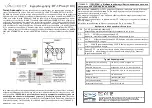
19 eleCTRiCal ChaRaCTeRiSTiCS
S1C63003/004/008/016 TeChniCal Manual
Seiko epson Corporation
19-5
(Rev. 1.1)
R/F converter circuit
19.4.3
3 V normal type
Unless otherwise specified: V
DD
=1.8 to 5.5V, V
SS
=0V, Ta=25
°
C
Item
Symbol
Condition
Min.
Typ.
Max.
Unit
Reference/sensor oscillation
frequencies
*
1
f
RFCLK
Ta=-40 to 85
°
C
1
–
2,000
kHz
Reference/sensor oscillation
frequency/IC deviation
*
2
D
f
RFCLK
/
D
IC
-40
–
40
%
Reference/sensor resistance
R
REF
/R
SEN
10
–
–
k
Ω
Reference capacitor and capacitive
sensor capacitance
*
3
C
RFC
/C
SEN
100
–
2,000
pF
Time base counter clock frequency
f
TCCLK
–
–
4.2
MHz
*
1 The oscillation frequency/IC deviation characteristic value may increase due to variations in oscillation frequency caused by leak-
age current if the oscillation frequency is 1 kHz or lower.
*
2 In these characteristics, unevenness between production lots, and variations in board, resistances and capacitances used in the
measurement environment are taken into account (variations in temperature are not included).
*
3 The CR oscillation can be performed if the resistance or capacitance is out of the range shown in the table (see characteristic
curves), note, however, that the oscillation frequency/IC deviation characteristic value may increase due to parasitic elements on the
board and those in the IC.
1.5 V low-voltage type
Unless otherwise specified: V
DD
=1.1 to 1.7V, V
SS
=0V, Ta=25
°
C
Item
Symbol
Condition
Min.
Typ.
Max.
Unit
Reference/sensor oscillation
frequencies
*
1
f
RFCLK
Ta=-40 to 85
°
C
1
–
2,000
kHz
Reference/sensor oscillation
frequency/IC deviation
*
2
D
f
RFCLK
/
D
IC
-40
–
40
%
Reference/sensor resistance
R
REF
/R
SEN
10
–
–
k
Ω
Reference capacitor and capacitive
sensor capacitance
*
3
C
RFC
/C
SEN
100
–
2,000
pF
Time base counter clock frequency
f
TCCLK
–
–
1
MHz
*
1 The oscillation frequency/IC deviation characteristic value may increase due to variations in oscillation frequency caused by leak-
age current if the oscillation frequency is 1 kHz or lower.
*
2 In these characteristics, unevenness between production lots, and variations in board, resistances and capacitances used in the
measurement environment are taken into account (variations in temperature are not included).
*
3 The CR oscillation can be performed if the resistance or capacitance is out of the range shown in the table (see characteristic
curves), note, however, that the oscillation frequency/IC deviation characteristic value may increase due to parasitic elements on the
board and those in the IC.
Current consumption
19.4.4
3 V normal type
Unless otherwise specified: V
DD
=1.8 to 5.5V, V
SS
=0V, Ta=25
°
C, C
1
–C
6
=0.1µF, No panel load
Item
Symbol
Condition
Min.
Typ.
Max.
Unit
Current consumption in
SLEEP
I
SLP
When SLP is executed: OSC1=ON, OSC3=OFF
–
0.1
0.5
µA
Current consumption in
HALT
I
HALT1
OSC1=32kHz Crystal, OSC3=OFF
–
0.5
1.5
µA
I
HALT2
*
6
OSC1=32kHz Crystal, OSC3=4MHz Ceramic
–
60
120
µA
I
HALT3
*
6
OSC1=32kHz Crystal, OSC3=2MHz CR (external R)
–
110
220
µA
I
HALT4
*
6
OSC1=32kHz Crystal, OSC3=500kHz CR (built-in R)
–
25
55
µA
Current consumption
during execution
I
EXE1
OSC1=32kHz Crystal, OSC3=OFF, CPUclk=OSC1
–
2.3
4.5
µA
I
EXE2
*
6
OSC1=32kHz Crystal, OSC3=4MHz Ceramic,
CPUclk=OSC3
–
220
440
µA
I
EXE3
*
6
OSC1=32kHz Crystal, OSC3=2MHz CR (external R),
CPUclk=OSC3
–
200
400
µA
I
EXE4
*
6
OSC1=32kHz Crystal, OSC3=500kHz CR (built-in R),
CPUclk=OSC3
–
50
100
µA
I
EXE5
*
7
OSC1=32kHz Crystal, OSC3=550kHz CR (built-in R),
CPUclk=OSC3
–
40
60
µA
Current consumption during
execution in heavy load
protection mode
I
EXE1H
OSC1=32kHz Crystal, OSC3=OFF, CPUclk=OSC1
VDHLMOD=1
–
13
25
µA
LCD circuit current
(V
C1
reference)
I
LCD1
DSPC[1:0]=All on, LC[3:0]=FH, OSC1=32kHz,
V
DD
=1.8 to 5.5V, VCREF=0
*
1
–
0.45
*
4
1.2
µA
LCD circuit current in heavy
load protection mode
(V
C1
reference)
I
LCD1H
DSPC[1:0]=All on, LC[3:0]=FH, OSC1=32kHz,
V
DD
=1.8 to 5.5V, VCREF=0, VCHLMOD=1
*
1
–
13
25
µA
















































